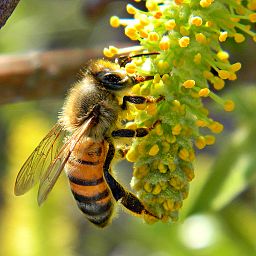By Monte Morin
When it comes to zeroing in on nectar-rich flowers, worker honeybees rely heavily on their expert sense of smell. But new research suggests pollution from diesel exhaust may fool the honeybee’s “nose,” making their search for staple flowers all the more difficult.
In a paper published recently in Scientific Reports, English scientists concluded that two components of diesel exhaust — nitric oxide and nitrogen dioxide — could alter the odor of the many chemicals that combine to give a flower its signature smell.
This phenomenon, researchers said, could either hinder or prevent honeybees from reaching their target flowers, and, in the process, inhibit the pollination of the world’s principal food crops.
The research comes at a time of great concern over the fate of pollinator insects. Globally, their numbers have been on the decline, and the potential consequences for humans are great.
The economic value of pollination across the planet has been estimated at more than $200 billion a year, and 70 percent of the world’s food crops rely on this process, according to lead study author Robbie Girling, a chemical ecologist at the University of Southampton.
“Honeybees have a sensitive sense of smell and an exceptional ability to learn and memorize new odors, enabling them to use floral odors to help locate, identify and recognize the flowers from which they forage,” wrote Girling and his colleagues.
In order to test their hypothesis, researchers synthetically reproduced the odor of bright yellow oilseed rape flowers. The scent of the actual flower is the result of eight different chemicals mingling together, and researchers used these same chemicals to reproduce the odor in the lab.
Next, they took worker honeybees that were raised at the university and “taught” them to associate the synthetic odor with nectar. They did this by restraining the bees, exposing them to the smell, and then swabbing their antenna with a sweet, nectar-like sucrose solution.
In the wild, worker honeybees will detect sweet nectar with their antenna. The bees then reflexively extend their proboscis — a long hollow tongue — and begin sucking up the liquid.
By repeatedly swabbing the captive bees’ antenna with the sucrose solution and exposing them to the plant odor, they hoped to induce a Pavlovian response, whereby the bee would eventually extend its proboscis whenever it caught a whiff of the lab-made perfume.
Finally, study authors exposed the trained honeybees to the pure flower smell, as well as versions that were altered to mimic the effects of exposure to nitric oxide and nitrogen dioxide.
What were the results? Researchers said flower odors that mimicked the effects of pollution were roughly half as likely to make the bees stick their tongues out than the unadulterated smell. Researchers deemed this a “significant reduction in recognition.”
While study authors acknowledged that their conclusion was the result of manipulating synthetic odors, not field observations, they said the disruption of natural odors by man-made pollution could have far-reaching effects.
“In nature honeybees use a combination of visual stimuli and floral odors to locate a flower for the first time,” authors wrote.
“Degradation of an odor source by pollution is likely to be more pronounced at distance from the flower, where concentrations of the odors are lower,” they wrote. “This could result in greater dependence upon other senses critical for foraging behavior, such as vision, to compensate for the reduction in olfactory stimuli.”
©2013 Los Angeles Times
Visit the Los Angeles Times at www.latimes.com
Distributed by MCT Information Services



